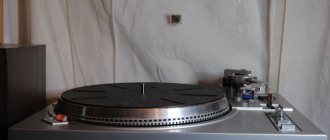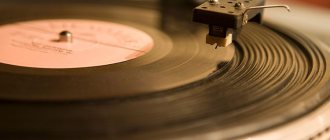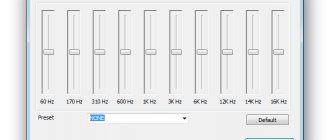We continue to look at what a vinyl installer might need in practice. In this part of the review, we will look at such important and necessary things as clamps, various mats, strobes and devices for tuning turntables, and talk a little about envelopes for storing records. When examining each specimen under examination, it is important not so much to understand its basic properties as its operating principles, and how to choose not only the highest quality and most convenient items, but also those most suitable for each user.
Beginning of the review: How to clean the stylus and records, how to properly install the turntable and other vinyl drive tools (part 1)
We press the records and crush the resonances using a clamp
A clamp is often a very necessary, but also very controversial accessory for a turntable. If you look at history, such accessories appeared much later than the heyday of vinyl as a medium. Nowadays you can come across a variety of approaches: there are manufacturers who do not recommend using any clamps with their devices, there are also those who make their own clamps, often of a tricky collet or screw design, and these clamps are included with the turntables as a mandatory requirement. parts.
Criteria for evaluation
We collected all or almost all of the accessories, tools, or even appliances presented in the test in an unconventional, but quite understandable way - we simply went to the store where all this was sold and “looted” the display cases. Those. We studied everything that can be encountered in everyday life. From experience I know all this, some are better, some are worse, and the user properties of each instance are not difficult to evaluate in practice.
There are several theoretical justifications here, from the need to somehow straighten the record if it is slightly curved, to the complete rigid fixation of the record to the main disk during playback. But the truth, as usual, is somewhere in the middle. I discuss the issue of using clamps in almost every player test, based on the properties of specific devices. After all, everything is not so simple in practice. Different designs (simply clamps, collet or screw clamps) work differently. Clamp materials also have an impact, and weight affects not only the sound, but also the load on the bearing and motor. In terms of record alignment, almost no clamp is ideal; you need either a vacuum clamping system, as Japanese manufacturers, for example Micro Seiki, did in their time, or two clamps - in the center and along the edge, as VPI now does on older models of turntables. In the case of ordinary clamps, which can be purchased in a store, there is no definite correct solution. For some, a heavy clamp weighing a kilogram will be suitable, while in another case, a light collet clamp will be more successful. There is no single rule here, except that you should not unnecessarily load devices with light disks and not very massive bearings.
01. Heavy metal clamp Pro-Ject Record Puck - RUB 3,500. 02. Clamp with carbon insert Millennium Audio Silentor RUB 10,300. 03. Aluminum collet clamps are not very heavy for their size. 04. Lightweight collet clamp, it weighs quite a bit. 05-06. Stacked Thorens Stabilizer clamps fastened with rubber rings - depending on color RUB 7,500–8,500.
Everything else - weight, design, material - works very individually. Although, having a lot of observations, I long ago came to the conclusion that if the condition of the plate allows you to do without a clamp, it is better to do so. Just press the plate down with a brush while cleaning it so it doesn’t slip. There are very few ideal clamps that do not suppress the airiness and transparency of the sound, and most often these are standard designs made by engineers for their specific models of players.
Adjusting the needle position
Look at the stylus from above: as the cartridge moves along the arc of the vinyl record, the stylus should be (relative to the groove) in the same position as the recording cutter is in while moving in a straight line. Then look at the end of the needle. It should be at an angle of 90° to the groove. Otherwise, the needle will begin to “read” unevenly. Because of this, the signal of channel 1 will be larger. Next, let's look at the needle from the side - how correctly did the needle “fit” in the groove, is it at the same angle as the recording cutter?
After this, we proceed to checking the distance from the center of the vertical post of the tonearm's rotating leg to the disk spindle (as a rule, this gap is indicated by holes on the platform of the tonearm itself). Here you need to follow the manufacturer's recommendations.
What is needed to correctly adjust the needle position?
You will need a “sacrificial” vinyl record that you won’t mind scratching, a device to measure tracking force (scales), a screwdriver, a template to determine the angular error, and a flashlight or bright lamp to clearly see all the details. In addition, you will need a magnifying glass and compact pliers with as thin ends as possible.
Then you need to make sure that all the wiring from the tonearm, as well as the solders, their contact tips are in perfect working order. Next, proceed to cleaning the contacts between the wire tips and the pickup head pins. Be extremely careful not to damage the wires in the area where they are soldered to the tip. After this, evaluate the quality of the pickup head mounting screws. They always need to be screwed in with force, so it is better to replace plastic ones with metal ones (brass, aluminum or stainless steel). To properly tighten the slotted screws, you will need a screwdriver with a handle of approximately 19 millimeters (jeweler's screwdrivers will not work).
How and why mats affect the sound of a vinyl player
It would seem that such a simple thing as a mat can significantly affect the sound and performance properties of the player. According to my observations, selecting a mat is the simplest and most effective way to adjust the sound in an already assembled tract, when there are no plans to change the components, but something needs to be adjusted a little. Why do you need a mat anyway? Sometimes it is really superfluous - many modern players are supplied without mats, they are neither included in the kit nor offered by the manufacturer as an option. Other manufacturers, on the contrary, have something in the kit and options. And there is a large selection of options from third-party companies.
The mat was invented in order to untie the needle and the plate from the noise of the motor
Historically, the mat was invented in order to untie the needle and record from motor noise and other unnecessary artifacts, but the technical level of turntables has long ago gone beyond the limits when this is really necessary. Today, the mat is an element of convenience so that the record does not slip on the disk or an element of fine sound adjustment. A turntable disk can be light or heavy, it is made from a variety of materials, but a direct combination of a turntable disk and a record is not always the best option. For example, most acrylic discs, despite their apparent neutrality, are still better to untie, but for metal discs, with very rare exceptions, this is a mandatory rule.
01. Thick leather mat Tonar Black Leather Mat - RUB 2,200. 02. Carbon Millennium Audio Carbon LP Mat - RUB 10,300. 03. Rubber Tonar Rubber Mat - 2750 rub. 04. Tonar Pure Cork Mat - RUB 1,300. 05 . Thick felt mat Millennium Audio M-LP felt mat red - RUB 2,600. 06. Thin leather mat Pro-Ject Leather it black - RUB 2,700. 07. Plastic Tonar Pure White Perspex Mat - RUB 1,850. 08. Cork mat with a removable central insert Millennium Audio M-Corkmat - RUB 2,300. 09. Mat made from a mixture of cork and crumb rubber Tonar Cork'n Rubber Mat - 2000 rub.
So, it doesn’t matter whether the player comes with a mat or not, or the design of the disc is such that the mat is not removable, nothing limits us in searching for different options and combinations. The only thing to remember is that selecting a mat of a different thickness should be accompanied by adjusting the tonearm in height and making fine adjustments. If the tonearm does not have such settings, everything becomes more complicated. Let's say everything is regulated here. What can we choose? There are all kinds of plastics, rubber, carbon, wool, cork and mixtures based on it, leather, glass, even ceramics or copper - such mats also exist in nature. But before you plunge into all this diversity, you need to understand whether it is necessary and why.
The main things that matting can affect are transparency, airiness of the mid-upper range, balance imbalances, excessive coldness or, conversely, warmth of sound. And here you can try to derive some formulas. If the sound is too warm, muddy, or there is a block in the mid-upper range, hard mats, even glass or ceramics, are more suitable. If the sound is sharp and cold or there is tightness or too much bass, you probably need to pay attention to materials such as cork or felt; sometimes thin leather may be suitable.
If you purchased your first turntable, you don’t have to buy a mat right away.
Rubber mats are more suitable for old budget devices with imperfect mechanics. Carbon or hard plastics - things are more complicated with them; there are cases and combinations when such mats work well, but more often it happens that some characteristics improve, while others worsen. Yes, and if you purchased your first player, it is not at all necessary to immediately buy some kind of mat, even if it is not included. First you need to completely set up the device, let it run in for the prescribed 40-50 hours, and only then try to determine whether additional intervention in the design is needed or not.
Structurally, solid mats are more convenient, without tricks such as a removable center. But for mats made of hard materials, it is highly desirable to have a recess for the apple of the plate. Another useful property is that simple and inexpensive plastic mats can be used instead of a dust cover, but just an unnecessary plate will do for these purposes.
Choosing a location for installation
The ideal stand for a turntable is completely horizontal, low-resonance and installed as far as possible from vibration sources, including speakers.
For a hard concrete floor, a floor stand is optimal; but on a suspended wooden floor it will enhance the impact of footsteps. In this case, we recommend a special wall shelf; it will completely eliminate the problem of steps. Just don't forget about reliable bolts and fasteners, otherwise the consequences may be too destructive.
Most turntables come with some form of insulation, from simple rubber feet to elaborate full suspension systems. The better it is, the less capricious the turntable is at the installation site. A model of any design always benefits from proper placement and solid support.
Setting up the player according to a template and the obligatory strobe light
Setting up the player is the most important component that determines how the sound will turn out. It is enough to make a slight mistake with the geometry, and not only will the sound become worse, but the records will also wear out more if the needle is positioned incorrectly in the groove.
01. Tool for setting Pro-Ject Align it - 6300 RUR. A little inconvenient, but the principle of operation is correct. 02. Dynavox Full Length Strobe Disc. 03. Small strobe disk Scheu Analog - also works, but with small disks it is still better to use a strobe lamp. 04. Universal template Tonar Schablone - 2300 rub.
A little overwrought, the execution a little sloppy. It is best to understand the settings carefully and gradually. Different tonearms are configured differently, some are very simple, and some even an experienced vinyl recorder will have to tinker with. In addition, different heads are differently critical to settings errors. The situation with configuration tools is much the same. You can configure the player using a standard template, almost always included in the kit. Here the result depends not only on skills, but also on the convenience and quality of the attached template. Errors may vary in different cases. You can use some kind of purchased template, fortunately there are a lot of them: for different tastes and for a variety of money. The question is different, you still need to know how to use the template. In addition, the degree of convenience and quality of models vary.
You still need to know how to use the template
In practice, besides the simplest option, which I have already mentioned, and the help of a professional adjuster, you can choose two paths. Or understand in more or less detail how all this geometry is constructed, how the position of the head, the angles are determined mathematically, and what influences what, or you can choose the most suitable template for your tasks, already tested and tested by other audiophiles, and master settings using it. The first, more thoughtful option is, of course, preferable. At a minimum, you will understand the relationships and, based on this, you will be able to configure different systems, determine what is wrong and where and why. The second option is simple and utilitarian, but if you work carefully and accurately with the settings and sound, everything will be in perfect order.
In practice, if possible, it is better to choose universal, not the most primitive, but not overloaded templates. If the template allows you to set the needle approach, this is always a plus; if it is possible to adjust both according to calculations according to the Baerwald method, and according to Lofgren or according to Stevenson, that is also a plus. You can understand the essence of these settings, or you can figure out by ear how it turned out better. It is also possible, and often even necessary, to use some additional tools, for example a mirror or a grid applied to a transparent block, to adjust the azimuth and altitude; these things make the process easier and make the results more accurate. True, if you don’t look into it in detail, there is one catch - how can you be sure that everything is really done correctly and works exactly as it should? Therefore, I repeat once again, the time and effort spent on analyzing the theory is not at all superfluous. However, you can still check some things, and here test plates can help us.
There must be a strobe
With stroboscopes, everything is obvious - there must be a strobe. It may be the simplest, but it must. Even if the device has a speed stabilization system, it is worth checking it sometimes. If there is adjustment, even more so. A small strobe disc is the bare minimum. Full size is more convenient. If the kit includes a special lamp, that's even better. If there is no lamp, it is worth remembering that all stroboscopic disks operate under lighting with a frequency of 50 Hz (or increased, a special lamp with a frequency of 300 Hz will give a clearer picture), and it will not be possible to measure something, for example, in daylight.
Envelope and envelope are different
This topic is a little out of context, but I decided to include it for this reason - firstly, the amount of dust and static on it will depend on how the record is stored, in addition, there may be more or less damage. And secondly, for envelopes they usually go to the same store where they buy everything else.
01. Envelopes Goldring Extatic Record Sleeves - 2600 rubles for 25 pieces. 02. Paper envelopes with film insert. The price can vary greatly, but the convenience depends on the materials and execution. 03. Film bags Nagaoka Anti-static record sleeves No102 - 1650 rubles for 50 pieces. In my opinion, they are a little thin and wrinkle often. 04. Mobile Fidelity Original Master Record Sleeves - 1800 rubles for 50 pieces.
In my experience, these are the most convenient envelopes. I will not consider outer envelopes, they simply must be of high quality, fit well, and with or without a flap and seal, decide according to your taste and situation. Inner envelopes are a more complex topic. It would seem that there is something there, but there is nothing. The envelope must be reliable, convenient, easy to clean and remove, and have antistatic properties. There is usually a choice - just paper envelopes, completely useless in all respects, but for some reason they are sold, and all kinds of film, and their combinations. The film is convenient only when it is not completely thin and does not wrinkle from any manipulation. The most convenient envelopes are a combination of film and paper reinforcing it. It would seem like a small thing, but everything consists of little things, and important little things.
What is the difference between MC and MM cartridges?
Any radio interface (in this case, between the cartridge and the phono preamplifier) requires both components to match certain electrical parameters, such as gain and impedance, in order to transmit information as completely as possible.
MM cartridges tend to have more uniform electrical characteristics, allowing manufacturers to design one circuit to suit almost everyone. For heads of the second type, everything is not so simple.
MC cartridges with a high output signal level are almost no different from their MM counterparts, while for heads with a low level it is many times less. To optimize the signal-to-noise ratio, the phono stage must provide variable gain. For most MM cartridges, 40 dB will be enough, MC models need from 50 to 70 dB.
Magnetic coils also vary in resistance, capacitance, and inductance, all three of which contribute to the overall impedance. Correctly selected, they ensure optimal connection of the cartridge and phono stage, as well as higher quality sound.
Most MC cartridge manufacturers specify acceptable values for these parameters; but as always, it's worth experimenting with.
It may turn out that in your system, a small change in one indicator will make the sound noticeably better. Typically, as resistance decreases, sound density increases and tonal expressiveness decreases. As a rule, its value is from 100 to 500 Ohms.
Capacitance ratings range from 200 picofarads to 1 nanofarads - the higher the value, the more the highest frequencies are filtered out. If your system is transparent enough, the changes will be clearly audible.
Benefits of Test Vinyl Records
Nowadays test plates are a very common thing, it is not difficult to purchase them, but in practice two questions often arise. First: which record should I choose? Second: which of its capabilities can be used and how?
What exactly is a test plate? The vinyl disc on which the test signals are recorded has specialized tracks for determining tuning parameters or adjusting them. There are also discs, for example, with empty areas (just smooth surfaces). Usually, each manufacturer accompanies its publication with detailed instructions, although these instructions are not always in Russian, and for some this can be very critical - the same auto translators cope with such technical texts very mediocrely. But if you set your mind, you can find something online for almost every publication. It is also worth remembering that when you study all the potential capabilities of the test discs and select the desired parameters, it is not a fact that you will be able to find everything on one edition - after all, the set of tracks and features on different discs is different.
01. Cardas Frequency Sweep and Burn-in Record - 1600 rub. Not a bad disc, but not universal. 02. Image hifi Vinyl Essentials - 2200 rub. 03. Hi-Fi News Analogue Test LP - 2650 rub. One of the most convenient test plates, and the kit is good - in addition to the plate, there are also simple templates included in the kit. 04. Analogue Productions The Ultimate Analogue Test LP - 2400 rub.
I'll try to summarize what might be needed in practice. The most basic capabilities, almost always these are the first tracks on the first side - determining the correct channel connection and correct phase. Yes, both are worth checking; in practice, errors are not so rare. The next very convenient opportunity is to measure the resonant frequencies of a specific path, namely your head on your tonearm. It is no secret that not all tonearm manufacturers indicate the effective mass and not all heads are equipped with data on the compliance of the stylus holder. Namely, these values, in combination with the mass of the head, will give the values of the resonant frequencies, and check whether you fall within the permissible range or not, maybe something should be adjusted, decide on the choice of head, if the existing one is not suitable - here All this can be done with just a couple of test tracks on the record. An extremely useful feature.
What else might be useful? Tracks for setting anti-skating, more precisely for measuring the correctness of its settings, and zero “varnish” tracks. They can also be used to adjust the head position and anti-skating, but do all this not by ear, but by eye. And if you can adjust the geometry using a template, then with regard to anti-skating, with different features of the tonearm, head and its needle, one or the other method may be more informative. These are the main features, but there are usually more than a dozen tracks on the disc, and if you wish, you can master the use of all of them, if there is a need and you are confident that you can interpret all the data received correctly.
Correct tonearm adjustment
Let's reveal a little secret: the tonearm does not require constant maintenance. You only need to do everything correctly once and enjoy the performance of your player. Repeated adjustments will be necessary in case of transportation of equipment or after its repair.
And now - to the setup... Tighten the tonearm mounting screws properly. If you have a swivel tonearm, check that the bearings are in good shape by very carefully grasping it by the headshell and pulling the tonearm back and forth as gently as possible along the long part of the tube. Then make a few gentle rotational movements with the tonearm. If during this process you feel even a slight play, then the part needs replacement or high-quality repair.
The pickup head needs careful adjustment of tracking force, horizontal error angle and azimuth adjustment
Tonearms using viscous fluid damping require special considerations. Check whether there is enough liquid in the special reservoir or groove; Is it evaporating or leaking? If you notice the presence of dust in the liquid, then you just need to change it to a new one (recommended by the manufacturer). If you have a system with blades of different lengths, then you should make sure that each blade is installed correctly. And remember: high damping will make the sound thicker and denser (unfortunately, this can lead to a loss of fine detail in the sound), while very little damping will help achieve a “soft” and open sound (but can easily cause blurriness and ambiguity in the sound). Everything needs moderation.
Maintaining a balance between music and technology
In two parts of the test, we managed to cover a decent number of types and types of vinyl accessories, but once again, this is a small fraction of what is on the market. Sometimes you can come across very exotic designs, both in design and price. And if we add to this everything that was released in the past, the theme turns out to be of the “embrace the immensity” category. But this is precisely what is not necessary in practice. Look for the best, go through endless options - only if the process itself is interesting, and the results can be neglected. This approach has a right to exist, because everyone chooses their own components of a hobby. In practice, it is more important for many not to look for the best in the abstract, but to find their own, optimal, convenient in functionality and suitable in price, and, moreover, affordable for purchase. And although everyone determines the desired “degree of immersion” for themselves, I would not recommend diving very, very deeply, because the main thing in our case is the records and the music recorded on them. And just as with technology, this balance should be maintained without being scattered on everything at once.
As for ordinary everyday practice - when choosing any little thing, try to imagine how you will use it, is it convenient, how does the thing fit in your hand, and do you need it for business, and not to put it on a shelf next to player. At least for those things from which we need functionality, this is completely fair. For the same accessories from which we need certain sound properties, the approach is different. In the best case, it would be good to understand at least a little how materials and structures can act on each other, where what patterns exist. Yes, there may be almost more exceptions to the rules than the rules themselves, but your own understanding and understanding, developed with experience, is at least some guarantee of predictability of results and protection from unnecessary expenses.
We continue to work with the pickup head: set the azimuth
Azimuth – zero skew angle of the pickup head. You can set the azimuth using a mirror, but this is only possible for some pickups. For example, for pickups with a dynamic coil (for handmade parts), this adjustment will not be accurate.
There are 2 good methods for setting azimuth. First: using your own hearing. All you have to do here is turn the pickup little by little in different directions by tiny fractions of a turn. The main thing is to feel the “same” position that gives the deepest sound picture. But this method has a drawback - until you have enough experience in such “listenings”, you can easily get confused by the sound changes.
The most reliable method is considered to require the use of a test plate and a voltmeter. The azimuth is set so that at a frequency of 1000 Hz the crosstalk is exactly the same for both channels.











